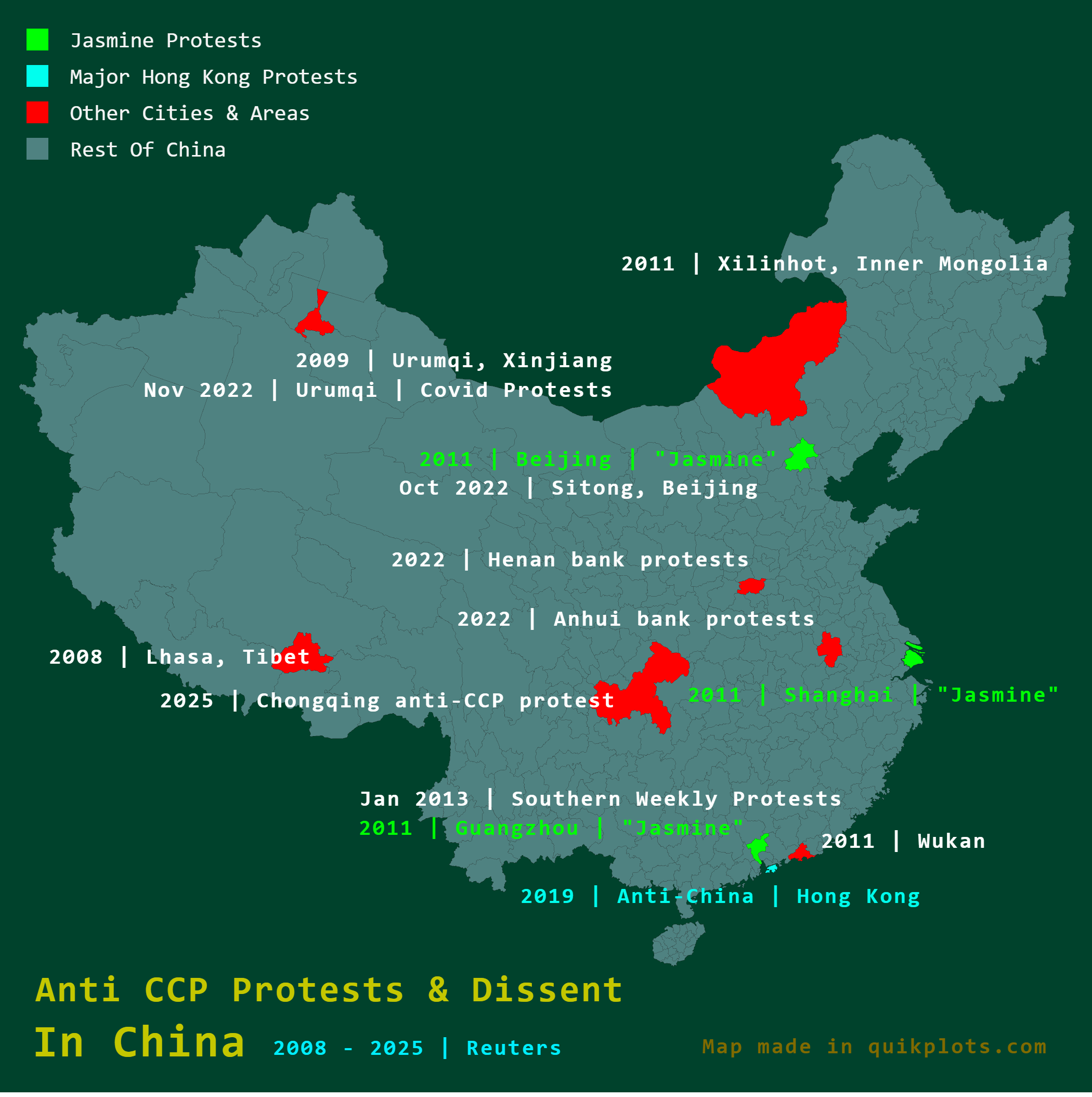Anti CCP Protests in China Map


Marcus Rodriguez
Historical Geography Expert
Marcus Rodriguez specializes in historical cartography and geographic data analysis. With a background in both history and geography, he brings unique...
Geographic Analysis
What This Map Shows
This map visualizes the significant anti-CCP protests that have occurred in China from 2008 to 2025. It highlights key events in various regions, showcasing the rise of dissent against the Chinese Communist Party (CCP) over the years. The timeline includes notable protests in Tibet, Xinjiang, Inner Mongolia, Wukan, Hong Kong, and major cities across China, illustrating a growing sentiment of resistance among the populace. Each marked location represents a focal point of unrest, revealing a pattern of dissatisfaction that spans nearly two decades.
Deep Dive into Anti-CCP Protests
The anti-CCP protests in China are a reflection of the complex social, political, and economic fabric of the nation. These uprisings stem from various grievances, including calls for political reform, ethnic rights, environmental issues, and basic human rights. Starting with the 2008 Tibetan unrest, where hundreds of monks marched in Lhasa, the protests have only intensified over the years, demonstrating a significant shift in the public’s willingness to voice dissent.
Interestingly, the 2009 unrest in Xinjiang highlighted ethnic tensions, particularly between the Uighurs and the Han Chinese. This marked the worst ethnic violence in decades, with Uighur activists protesting against systemic discrimination and cultural repression. The repercussions of these protests were severe, leading to a clampdown on Uighur culture and religion, which only fueled further resentment.
In 2011, the “Jasmine” protests drew inspiration from the Arab Spring, sparking a wave of demonstrations demanding democratic reforms. This was closely followed by several localized protests, such as the Wukan protests, where villagers protested against land grabs by corrupt officials. This pattern of localized dissent against specific injustices has been a hallmark of the anti-CCP movement, showing that while the protests may start small, they often resonate with broader issues affecting various communities.
Fast forward to 2019, when Hong Kong erupted into mass protests against an extradition bill perceived as an encroachment on its autonomy. This movement galvanized millions and became a symbol of the fight against authoritarianism in China. What’s fascinating is that the boldness of these protests not only caught international attention but also highlighted the growing divide between the mainland and Hong Kong.
In recent years, protests have continued to evolve. The 2022 Henan bank protests reveal how economic grievances can trigger public unrest, especially when people lose access to their savings due to banking fraud. Similarly, the 2022 Urumqi protests against stringent COVID-19 lockdowns demonstrated that health policies can also ignite widespread dissent. This interconnection between various issues—political, economic, and social—creates a complex landscape of protest activity in China.
Regional Analysis
The map captures a range of protest activities across different regions, each influenced by unique local circumstances. For instance, Tibet and Xinjiang have been hotbeds of ethnic unrest, where historical grievances against the Han Chinese government have led to recurrent protests. Meanwhile, in urban centers like Hong Kong, the protests have taken on a more political character, fighting for democratic freedoms and against perceived encroachments on local governance.
Additionally, Inner Mongolia’s protests in 2011 highlight local environmental issues and the rights of ethnic minorities, while the Wukan protests serve as a case study of grassroots mobilization against corruption and land appropriation. The contrast between rural and urban protest movements is particularly striking. Urban protests often draw larger crowds and gain more media attention, while rural protests might be more localized, focusing on specific injustices but still indicative of a broader discontent with CCP policies.
Significance and Impact
The significance of these protests cannot be overstated. They reflect a growing discontent that challenges the narrative of a unified, content society under the CCP’s rule. Each protest event contributes to a larger tapestry of resistance that could reshape China's political landscape. The implications of this dissent extend beyond China's borders, influencing international relations and perceptions of the CCP.
Moreover, as the Chinese government continues to tighten its grip on dissent through surveillance and censorship, the resilience of these protest movements may lead to unexpected consequences. The future projections suggest that as economic pressures increase and social media continues to amplify voices of dissent, we might see a more organized and widespread movement against the CCP in the coming years. Thus, understanding these protests is not just about geography; it's about the pulse of a nation grappling with its identity and future.
Visualization Details
- Published
- September 25, 2025
- Views
- 50
Comments
Loading comments...